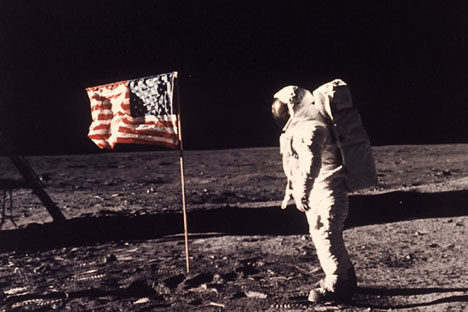
In this July 20, 1969 file photo, astronaut Edwin E. "Buzz" Aldrin Jr. stands next to a U.S. flag planted on the moon during the Apollo 11 mission.
APRussian space enthusiasts and engineers have raised $27,564 for a new mission to the Moon. They plan to launch a satellite that will photograph Apollo spacecraft landing sites. Many Russians still believe the American manned Moon landings were faked, but the organizers of this project hope to finally dispel all doubts.
The project was launched online on October 1, and the fundraising campaign ended on November 5. Organizers raised twice as much as originally intended. Over a 1,000 people pledged, with one person giving about $8,000.
The project's idea is what caught the public's imagination. Organizers plan to take images of the American landing sites with a ground resolution of 10 cm per pixel, which is three times the quality of NASA's pictures.
“There is this endless controversy about whether the Americans ever reached the Moon with the Apollo spacecraft,” blogger Vitaly Egorov, one of the project's founders, told RBTH. “The only way to resolve it once and for all is to actually go to the Moon and check. So far only the Americans have done it; they made photographs of the landing sites and the Soviet moon rovers, and made those available to the public. The problem is that some people don't believe those photographs are authentic.”
Personally, Vitaly is convinced the American Moon landing missions took place, but his project has other goals. ”I want to show that a group of ordinary people can carry out a space project,” he explained. “Young Russian engineers now working for the country's space industry are not happy with the fact that Roskosmos (Russia's Space Agency) only has the goal to orbit Earth.”
Over 20 young Russian specialists are involved in the project, and supporters include the Commission to Combat Pseudoscience that is part of the Russian Academy of Sciences, as well as the Museum of Cosmonautics, which provided a site for engineers to discuss their ideas. NASA astronaut Michael Lopez-Alegria spoke about the Russian project on Twitter.
Experts at Russia's Institute of Space Research and the United Aircraft Corporation can't help smiling at the young Russian specialists' ambitious endeavor. The project doesn't even have a fixed budget, which will be worked out during the first stage of satellite development.
There will be five stages in total: development and trajectory calculation; finalizing the initial outline; production; launch; and the flight itself. So far, organizers are planning to spend most the money to finance the first stage. As the fundraising goal was exceeded, the team will be able to start developing the first designs for the future satellite's devices, including the on-board computer.
The last Soviet mission to the Moon was in 1976, and the country's ultimate interplanetary mission – the launch of the Phobos 2 probe – took place in 1988. Since then, Russia has successfully launched only satellites; both Mars-96 and Phobos Grund missions failed, while the launch of the Luna 25 mission, originally planned for 2012, has been postponed until 2019. The country will take part in the ExoMars international mission, providing launch vehicles and some devices. Some Russian-developed systems are currently orbiting the Moon and Mars, but installed on Western satellites. Also noteworthy, Russia has provided a scientific device for the Curiosity rover on Mars.
All rights reserved by Rossiyskaya Gazeta.
Subscribe
to our newsletter!
Get the week's best stories straight to your inbox